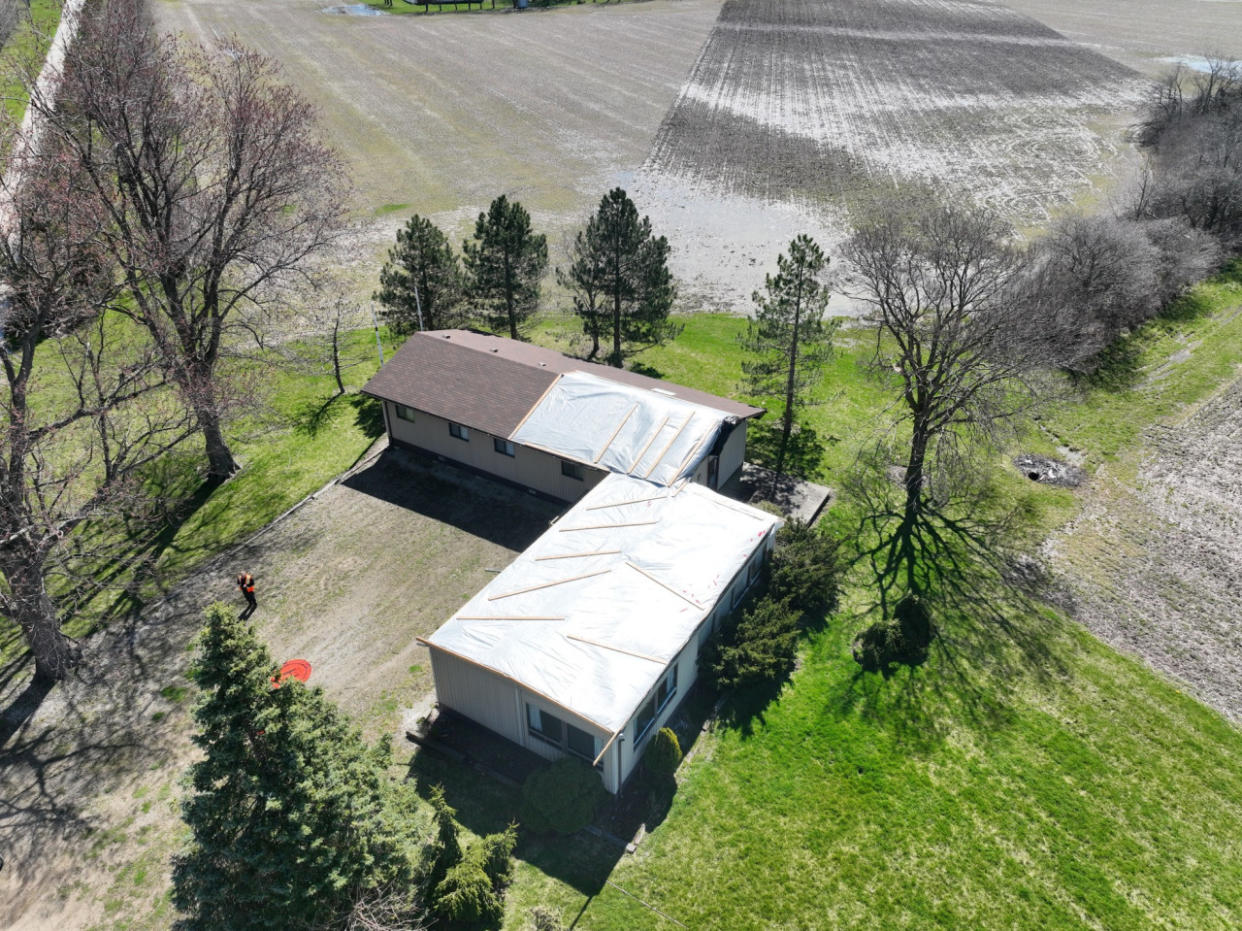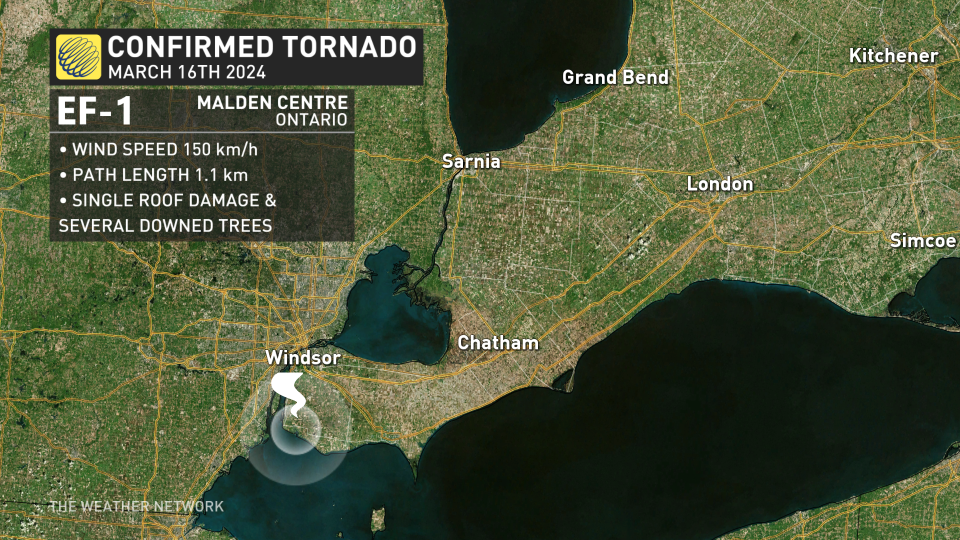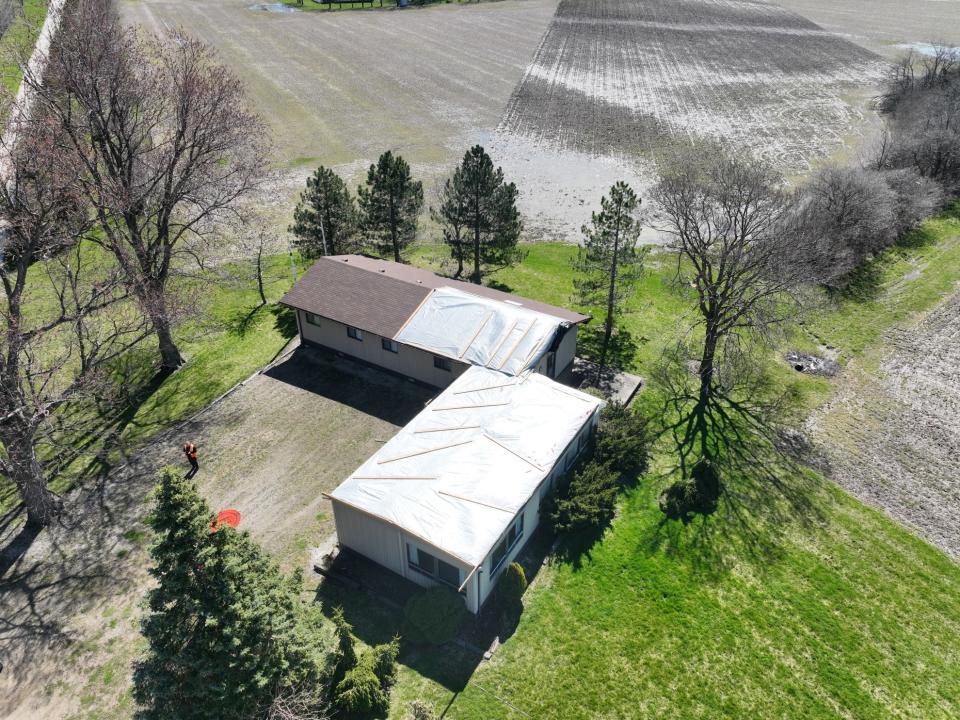Canada's first tornado of the year ties Ontario's earliest on record

The first Canadian tornado of 2024 has been officially recorded, and it happened last month.
On March 16, the EF-1 tornado with maximum wind speeds of 150 km/h, hit Malden Centre, Ont., according to The Northern Tornadoes Project (NTP). With that documentation, it ties the record for the earliest tornado ever recorded in the province –– an event that occurred in Clifford in 2016.
DON'T MISS: There's a big difference between an EF0 and EF5: Understanding tornado ratings

In an email interview with The Weather Network, Connell Miller, wind impacts researcher at NTP, said the event in Malden Centre "demonstrates the intense variability of tornadoes" since they can, theoretically, occur anywhere in Canada at any time of year.
"In my opinion, this shows the importance of the Northern Tornadoes Project to try and capture both what typically occurs in Canada, and these outlier events, to help Canadians understand Canada's tornado climatology," said Miller.
A storm damage survey was conducted on Saturday, April 13 after photo evidence of the March twister was sent to NTP.

Drone footage of the damaged mobile home | Northern Tornadoes Project
"The roof had been removed from a well-anchored, double-wide mobile home [with] maximum winds of 150 km/h, giving it an EF-1 rating. There was shingle damage and a downed tree at another residence, and numerous pine and spruce trees were downed in a woodlot further along the track," NTP said in a blog post on Monday. "More tree damage would likely have occurred if the trees had been leafed out."
Miller noted the details in its report a tornado system was sent to the group "well after the event had occurred" and the researchers acted on the information shortly after viewing it.
"We're grateful for the citizen scientists who provide us information on these difficult-to-find events," said Miller.
An area of tight rotation was detected with radar evidence in the exact location where the damage occurred.
Turns out the first Canadian tornado of 2024 occurred on March 16th at Malden Centre in SW ON. After an NTP ground / drone investigation, the tornado has been rated EF1 given it ripped the roof off a mobile home. Full details at the NTP blog: https://t.co/0M8q1UcLTa #ONStorm pic.twitter.com/CXnYypLict
Turns out the first Canadian tornado of 2024 occurred on March 16th at Malden Centre in SW ON. After an NTP ground / drone investigation, the tornado has been rated EF1 given it ripped the roof off a mobile home.
Full details at the NTP blog: Northern Tornadoes Project 🇨🇦 on Twitter: "Turns out the first Canadian tornado of 2024 occurred on March 16th at Malden Centre in SW ON. After an NTP ground / drone investigation, the tornado has been rated EF1 given it ripped the roof off a mobile home. Full details at the NTP blog: https://t.co/0M8q1UcLTa #ONStorm pic.twitter.com/CXnYypLict / Twitter" Northern Tornadoes Project 🇨🇦 on Twitter: "Turns out the first Canadian tornado of 2024 occurred on March 16th at Malden Centre in SW ON. After an NTP ground / drone investigation, the tornado has been rated EF1 given it ripped the roof off a mobile home. Full details at the NTP blog: https://t.co/0M8q1UcLTa #ONStorm pic.twitter.com/CXnYypLict / Twitter" Northern Tornadoes Project 🇨🇦 on Twitter: "Turns out the first Canadian tornado of 2024 occurred on March 16th at Malden Centre in SW ON. After an NTP ground / drone investigation, the tornado has been rated EF1 given it ripped the roof off a mobile home. Full details at the NTP blog: https://t.co/0M8q1UcLTa #ONStorm pic.twitter.com/CXnYypLict / Twitter"— Northern Tornadoes Project 🇨🇦 (@westernuNTP) Northern Tornadoes Project 🇨🇦 on Twitter: "Turns out the first Canadian tornado of 2024 occurred on March 16th at Malden Centre in SW ON. After an NTP ground / drone investigation, the tornado has been rated EF1 given it ripped the roof off a mobile home. Full details at the NTP blog: https://t.co/0M8q1UcLTa #ONStorm pic.twitter.com/CXnYypLict / Twitter"
"The rotation was located along the leading edge of thunderstorm outflow, making this a QLCS tornado," NTP says.
In a written statement submitted to The Weather Network, Lesley Elliott, NTP research meteorologist, said a tornado threat was not evident for southwestern Ontario on March 16, 2024, but there was a "slight" chance of thunderstorms that at least one model had indicated.
"The cooler air over the Great Lakes in the spring does generally have a stabilizing effect downwind. In this case, the storm migrated into the region from the west, and the tornado developed likely before the storm encountered cooler Lake Erie air," said Elliot.
Severe hail equal to or greater than a two-centimetre diameter was also reported in nearby Amherstburg, Ont., shortly before the tornado developed.
RELATED: Watch? Warning? How we communicate severe weather in Canada
"Certainly severe storm risk peaks in the summer months, but southern Ontario has already had a few days with severe storms," said Elliot.
At the time of the twister, no tornado warning had been issued.
Most tornadoes in Canada occur in June and July, but the season can also extend from April to September, especially across sections of southwestern Ontario and the southern Prairies. While a mid-March twister is typically more rare, it's not completely unheard of, as tornadoes can occur at any time of the year under the right conditions.
With files from Nathan Howes, a digital reporter at The Weather Network.
Thumbnail image courtesy: Northern Tornadoes Project.

